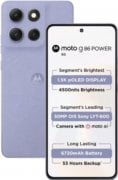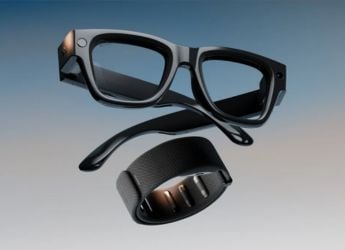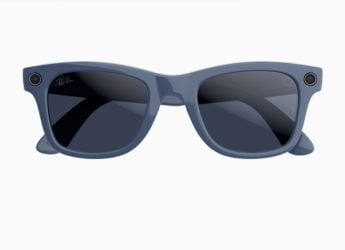- Home
- Wearables
- Wearables News
- Meta Ray Ban Display Smart Glasses Launched With a Screen and Meta Neural Band
Meta Ray-Ban Display Smart Glasses Launched With a Screen and Meta Neural Band
Meta Ray-Ban Display was launched at the Meta Connect event on September 17.

Photo Credit: Meta
Meta Ray-Ban Display features a single heads-up display at the bottom of the right lens
Meta Ray-Ban Display, smart glasses with an augmented reality screen, was launched at the company's Meta Connect event on Wednesday. It is a philosophical successor to the Ray-Ban Meta Glasses, which were launched in 2023 and arrived in India in May 2025. The new smart glasses continue to feature an ultra-wide camera on the left side of the frame, microphones, and custom-built open-ear speakers. But now, it also comes with a heads-up display (HUD) on the bottom of the right lens. The device also comes with Meta Neural Band, a surface electromyography (EMG or sEMG) Wristband that lets the user control actions via gestures.
Meta Ray-Ban Display: Price and Availability
The Meta Ray-Ban Display price is set at $799 (roughly Rs. 70,100), which includes both the glasses and the Meta Neural Band. It is available in Black and Sand colourways. The smart glasses will go on sale on September 30 at limited offline retailers in the US, including Best Buy, LensCrafters, Sunglass Hut, and, of course, Ray-Ban Stores. Expansion to Canada, France, Italy, and the UK will take place next year.
Unfortunately, an India launch is not planned currently.
Meta Ray-Ban Display: Specifications and Features
Meta Ray-Ban Display is the company's first attempt at making a smart glass with an embedded AR display. The smart glasses weigh 69g, making them slightly heavier than the Vanguard and considerably heavier than last generation's Ray-Ban Meta. The new display screen is placed near the bottom of the right lens. It is a 600 x 600 resolution screen covering about a 20-degree field of vision, and has a peak brightness of 5,000nits.
Despite the high brightness, Meta claims that the screen has just two percent light leakage, which means others around a user cannot see or identify the AR display. The screen supports a 90Hz refresh rate in general, and a 30Hz refresh rate while watching content.
The new Wayfarer frames house transition lenses, making them comfortable for both indoor and outdoor wear. These lenses support prescriptions between -4.00 and +4.00. Coming to the camera, the Meta Ray-Ban Display sports a 12-megapixel shooter with 3X zoom. It can capture up to 3,024 x 4,032p resolution images, and up to 1080p resolution videos at 30fps. The smart glasses come equipped with 32GB of built-in storage. The company says it can comfortably hold up to 1,000 images as well as 100 30-second videos.
Pairing up with the new AR glasses is the Meta Neural Band. First seen with the Orion prototype at the Connect 2024 event, it is an sEMG wristband that captures the minute muscle movements in the wrist and fingers, converts them into electrical signals, and sends them to the device, which then pairs the signal with a particular action. All of this to say, once a user has the wristband on, they can scroll through the screen or click on an interactive element with subtle movements of their fingers. Meta promises that in the future, users will also be able to write full messages.
The Meta Neural Band took four years of research to build, the tech giant said. It is built with Vectran, the same material used on the crash pads of the Mars Rover, making it both durable and bendable. It comes with an IPX7 rating for splash resistance, and is claimed to offer a battery life of 18 hours.
So, what can the Meta Ray-Ban Display do that regular smart glasses without a screen cannot? Meta AI now comes with visuals, allowing users to read the responses instead of just hearing them. It also supports sending and receiving text messages and video calls. The latter is only supported via WhatsApp and Messenger.
The HUD also doubles up as the camera's viewfinder, and with the new 3X zoom, users can see whether the zoomed view brings the subject into the frame or not. The screen can also be used for pedestrian navigation as well as live translation and captions.
For the latest tech news and reviews, follow Gadgets 360 on X, Facebook, WhatsApp, Threads and Google News. For the latest videos on gadgets and tech, subscribe to our YouTube channel. If you want to know everything about top influencers, follow our in-house Who'sThat360 on Instagram and YouTube.
- Samsung Galaxy Unpacked 2025
- ChatGPT
- Redmi Note 14 Pro+
- iPhone 16
- Apple Vision Pro
- Oneplus 12
- OnePlus Nord CE 3 Lite 5G
- iPhone 13
- Xiaomi 14 Pro
- Oppo Find N3
- Tecno Spark Go (2023)
- Realme V30
- Best Phones Under 25000
- Samsung Galaxy S24 Series
- Cryptocurrency
- iQoo 12
- Samsung Galaxy S24 Ultra
- Giottus
- Samsung Galaxy Z Flip 5
- Apple 'Scary Fast'
- Housefull 5
- GoPro Hero 12 Black Review
- Invincible Season 2
- JioGlass
- HD Ready TV
- Laptop Under 50000
- Smartwatch Under 10000
- Latest Mobile Phones
- Compare Phones
- Oppo K13s
- Redmi 15R 5G
- Vivo Y31 Pro 5G
- Vivo Y31 5G
- Oppo F31 5G
- Oppo F31 Pro 5G
- Oppo F31 Pro+ 5G
- Realme P3 Lite 5G
- Acer Nitro V 16S (2025)
- Acer Nitro V 16 (2025)
- Moto Pad 60 Neo
- Xiaomi Moaan InkPalm Mini Plus 2
- NoiseFit Endeavour Pro
- Apple Watch SE 3
- Elista QLED Google TV
- TCL C72K QD Mini‑LED TV
- Asus ROG Ally
- Nintendo Switch Lite
- Haier 1.6 Ton 5 Star Inverter Split AC (HSU19G-MZAID5BN-INV)
- Haier 1.6 Ton 5 Star Inverter Split AC (HSU19G-MZAIM5BN-INV)












